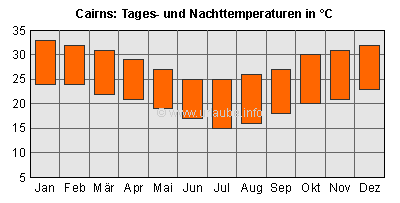Weather and Climate in Australia

As known, Australia is located at the southern hemisphere; this is the reason why some things are different from Europe: compared to the northern hemisphere, in Australia, the seasons appear in the opposite order, that means, spring time is from September to November, summer from December to February, autum from March to may and winter from June to August.
Climate data of Cairns  But in Australia, the seasons are not everywhere so pronounced the way we know it. Only in the south of Australia there are different seasons as it is the way in central Europe. Tropical temperatures with seasonal fluctuations specially appear at the north due to the proximity to the equator. The centre is marked by continental climate with few rainfalls. In the north, the hottest months are November/December, in the biggest part of the continent January, and February/March in the south. From June to August, there are the coolest seasons in the red continent.
The temperatures are influenced by huge land masses in the interior of Australia, there is a so-called continental climate. In the Australian summer there are average temperatures of 30-35°C in the outback, but in the summer time there are also hear waves with temperatures exceeding 40-45°C in all parts of the country. In the proximity of the coast, they rarely last more than 4 days, but in the inner country often more than 20 days.
The longest heat period in Australia has been determined in Marble Bar at the north/west of Australia in the year 1923/24. During exactly 161 sequential days, the temperatures raise to more than 37,8°C. The heat record of the country was beaten by a small city called Cloncurry in the federal state Queensland with 53°C in the shade.
After the antarctic, Australia is the driest continent on earth. In Australia, the rainfalls are unequally distributed. In centre of the country it nearly does not rain at all, while in the tropical regions and in the tempered south it rains a lot.
Every year, some natural disasters occur in Australia. In section, every three to five years, some bigger inundations appear caused by strong rainfalls in conjunction with cyclones. In Australia, bush fires occur with a different frequency and intensity. In New South Wales and Victoria, bigger fires occur about every three years. In the other federal states as Queensland, west Australia but also Tasmani, some bigger bush fires already appeared.
Due to the geographical situation of Australia, different travel times apply to the different areas. In principle, the east and west coasts can be traveled during the whole year, but for the northern coasts in the east and the west , the same rule as for the tropical north applies. Rainy season (Wet Season) and tropical heat.
The most pleasant place to travel to during the whole year is to the south. For example, in the north of Sydney, in the winter it already gets cooler at the coast, the water is even quite cold. The most beautiful season is the Australian summer in the south of the country. In autum and winter, it gets very cold and windy in the south, in the Australian Alps it can snow.
In the tropical north, the rainy season (wet season) is from November to April. During this time, the climate is hot and humid, so that storms and fierce, short rainfalls daily happen; Also cyclones can appear. Then the streets are impassable due to the floodways after a strong rainfall. Before taking an isolated stretch of way, one should get well informed about the road conditions at the local police authorities, the rangers or also the roadhouses.
The poisoned jellyfishes called box jelly fish make it impossible to bath at the north and north/east coast between December and March. On the islands and at the outer Great Barrier Reef there is no danger for snorkeling and diving excursionists.
The best traveling time for the tropical north is from April to November, but also the rainy season is fascinating with its storms, florescence of plants and many water birds. The best traveling time for outback travelers is the dry period of the Australian winter, thus the central European summer. Here, the temperatures are still pleasantly high, but at nights it mostly gets very cold. The Australians themselves do not travel to the outback during the Australian summer, as the heat there is insupportable. But among us Europeans it is very popular to travel to the red centre during this time.
As conclusion there is to say that Australia can be traveled during the whole year; the decisive thing is to which area it is traveled. But one should not forget that even in Australia the weather is foreseeable. This means that the dry/rainy period can be shifted for some weeks. Thus, as a traveler, one has to take a certain risk in one's travel planning.
Climate Graphs
The adjacent Graphs show the climate in different cities of Australia. The cities Cairns, Brisbane and Sydney represent the east coast (from north to south), the city Melbourne the south coast, and Perth the west coast. The climate data of Alice Springs show the daily temperatures and the fluctuation of temperature between day and night one will have to adapt to by spending some days in the outback. It also gets evident that in the outback, the least rainfalls and the most sunshine hours occur.

Back to the index Australia
Author: Simone Palm; Copyright: Patrick Wagner, www.tourist-guide.biz
|